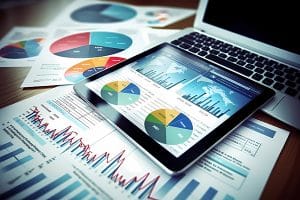
Chris Kuehl
Managing Director • Armada
Q3 Real GDP estimates showed surprising growth of 4.9%, largely on the back of stable consumer spending, strong nonresidential construction, some mild inventory building activity, and government spending. Forecasts for next year show a weaker Q1 and Q2 potentially. Manufacturing activity to support various war efforts, rebounding US automotive sector, and a strong aerospace sector could increase growth. Headwinds from higher interest rates (slowing potential construction activity) is likely to provide additional risk.
The Fed is watching the relationship between inflation and wage growth closely. LendingClub surveys show that 60% of US households are living check-to-check with more than 20% of those households struggling to pay essential bills. Until Q3 of this year, inflation has been outpacing wage growth (for nearly 9 months) and has finally inverted.
Wage growth averaged 2.5% in the decade prior to the pandemic, and the Fed knows that it will eventually slow to that 2.5% pace. It must get inflation to its 2% target rate to ensure that households can build discretionary income. The bottom line is that the relationship is now good (wages outpacing inflation), but both are still too high. Directionally, it is correct. But this will keep the Fed “higher for longer”. The Federal Funds Effective Rate is likely near its “Peak Hike Cycle”. There are many factors that will shape a decision by the Fed to stop future hikes, and with so much global uncertainty it is difficult to know if the Fed is truly finished hiking. The forecast includes one more 25 basis point hike before the end of the year (in the November meeting). That may change. The concern looking forward is that the full impact of this entire hike cycle has not been fully felt. Much of the pressure in the financial markets, bank credit tightening, interest rate impacts on consumer spending, etc. have yet to be fully felt and will likely flow through the economy in 1H ‘24.
Consumer spending accounts for 70% of GDP and forms the core of US economic activity. The retail sales outlook models show that retail spending is forecasted to remain strong through the end of 2023 and into 2024. These models have been trained over a twenty-year data period, and the performance of the models are in the mid and high 90% range in the 3 and 6 month time frames. According to our current outlook, retail spending will grow by 2.5% in Q3 (when final figures are released) and 2% in Q4. For the full year 2023, that would put growth at roughly 6.7%. For 2024, the retail sales forecast remains firm, but growth slows to 3.59%. The long-term curve shows retail sales setting new highs in 2024.
The interesting component of what the models are “seeing” is that there is no consumer recession. There are no soft periods in the forecast for now. Job openings remain high, unemployment is low, wage growth is stable at 4.1% (if not too hot), and inflation is cooling. All of those factors would feed consumer income and fuel spending. Offsetting that is of course higher interest rates for interest-bearing purchases, higher debt loads for middle- and lower-income households, and weaker consumer sentiment currently.
The outlook for overall US Industrial Production in Manufacturing (IPMAN) includes both durable and non-durable goods. This month’s model showed some slight softening in the tail-end of the curve with the second half of 2024 coming in weaker under a new set of scenarios. The model is now showing full-year 2023 growing at 3.97% in manufacturing (2.03% last month). The 2024 outlook improved slightly but remains weak with the full year contracting at an estimated 2.18% Y/Y rate (2.07% last month. This view strips out the utilities and mining portion of industrial production and focuses solely on manufacturing activity. The longer-term view is still showing a more moderate dip on a historical basis (an even shallower recession), but overall production appears to stay just below the long-term trendline. These models are updated monthly and there appears to be a downside bias in the data for the second half of 2024. Keep in mind that the IPMAN model includes both durable and nondurable goods categories. Some durable sectors are seeing strong new order demand, while some non-essential / non-durable and durable categories are weaker. Defense spending will also positively affect total demand.
Recent Posts
- The All Powerful and Influential Automotive Sector July 10, 2025
- Tariff Fatigue June 24, 2025
- Obtaining Financial Records from Hesitant Customers May 29, 2025
- What Happens Next? May 8, 2025
- Three Reasons to Ignore Recession Talk (and One Reason Not to) April 24, 2025
- Stability in Uncertain Times: Insights on Small Business Performance and Market Trends March 26, 2025











